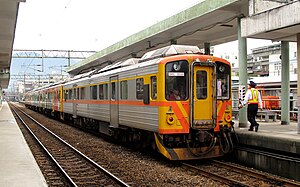TRA series 45DR1000
| TRA series 45DR1000 | |
|---|---|
|
DRC 1035 (February 14, 2013)
|
|
| Numbering: | DR1000-DR1036 |
| Number: | 36 |
| Manufacturer: | Nippon Sharyō Seizō / Taiwan Tangrong Iron Works |
| Year of construction (s): | 1998/1999 |
| Gauge : | 1067 mm ( cape track ) |
| Length over coupling: | 19,774 mm |
| Height: | 3890 mm |
| Width: | 2690 mm |
| Service mass: | 39.81 tons |
| Top speed: | 110 km / h |
| Installed capacity: | 350 hp (257 kW) |
| Motor type: | Cummins NTA855-R1 |
| Rated speed: | 2100 rpm |
| Drive: | diesel-electric |
| Brake: | Air brake |
| Coupling type: | Janney claw coupling |
| Seats: | 42/46 |
The railcars of the 45DR1000 series of the Taiwanese Railways (TRA) were manufactured in Japan in 1998/1999. They are used on branch lines.
history
At the end of the 1990s, the around 60-year-old diesel multiple units of the 35DR2100 and 35DR2400 series were worn out. The TRA therefore decided to replace these secondary rail cars with new vehicles. These should now also have air conditioning.
As part of the 810 Car Purchase Plan , the order for 36 corresponding vehicles was therefore triggered. The first two railcars were manufactured in 1998 by the Japanese company Nippon Sharyō Seizō . Series production then began in 1999 in the Korean Taiwan Tangrong Iron Works .
The railcars were given the numbers 45DR1001 to 1036. The 1036 was later converted to an inspection vehicle and received the number 45DSC1001. It was often called "Taiwan No. 1" because the railway director carried out inspection trips with the railcar. In 2014, however, it was dismantled again for use in passenger transport. To distinguish it from other branch line vehicles , the series is also referred to as DRC #.
The railcars are equipped with multiple controls, and trains with up to four cars also run.
It is used primarily on the secondary lines Pingxi (Sandiaoling – Jingtong), Neiwan (Hsinchu – Neiwan) and Jiji (Ershui – Checheng). On the Yilan route they were used in the shuttle service between Luodong and Suao until 2004.
Constructive features
The power transmission is diesel-electric . There are two Cummins diesel engines in each railcar . An NTA855R1 with an output of 257 kW (350 PS) drives the traction generator. A second diesel engine, type 4BT 3.9L GR2, supplies the energy for the air conditioning and the other electrical equipment. The cooler and the exhaust system with the silencers are on the roof. The railcars have a single axle drive. The traction motors are manufactured by Japan NABCO Co.
The outer skin is made of stainless steel and has five longitudinal beads on the vehicle wall. The side walls are not painted. There is a yellow-red warning paint on the front sides. There are two pivoting sliding doors on each side of the car. The passenger compartment is a large area with longitudinal seats. The railcars are equipped with Janney couplings with lateral rigidity devices according to Japanese standards also used in the Taiwanese Cape Gauge Network. The couplings do not couple any electrical or pneumatic connections; these are made using separate line couplings.
Web links
- http://emu300ct.web.fc2.com/index/tramus/45DR1000.htm - Chinese
- http://blair-train.blogspot.com/2010/02/dr1000.html photos, videos (chinese)
